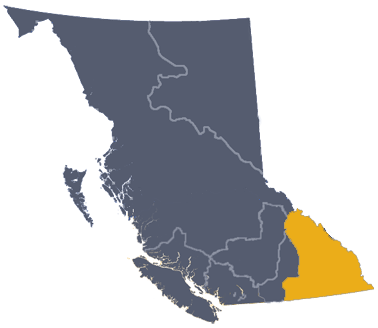Kootenay - Overview
The Kootenay region features high mountain slopes and wide, fertile valleys. The relatively remote location creates strong local demand, and is fuelling an emerging processing sector that produces added-value meat, honey, fruit, dairy, wine, and wool and soap products.
Growing conditions
Kootenay region has a moderate climate, allowing for a wide range of crops. Higher mountain areas provide grazing for a large beef cattle sector, while the Creston Valley produces abundant crops.
Crops, livestock and food processing
Products include apples, cherries and other tree fruits, tomatoes, vegetables, forage, forage seeds, cereals and oilseeds. In addition to summer Crown-land grazing, the cattle sector is supported by forage crops, which grow well in the river valleys. Livestock production in this region includes extensive beef and dairy cattle production as well as poultry, goats and specialty livestock like llamas.
Local Kootenay information
Find out more specific information about the Kootenay agricultural region:
Regional agrologist
Jeff Nimmo
Telephone: 778-666-0568
Email: Jeffrey.Nimmo@gov.bc.ca
Resources
The ministry has developed regional guides as a resource for producers, on-the ground researchers, and consultants to reflect on the climate issues challenging environmental sustainability and local farm businesses and food production.

The Kootenay region includes East Kootenay Regional District (Cranbrook, Invermere); Central Kootenay Regional District (Creston, Nakusp, Nelson); Kootenay Boundary Regional District Areas A and B (Rossland, Trail), Columbia Shuswap Regional District Areas A and B (Revelstoke, Golden).
Contact information
AgriService BC
Have a question? Call or email and a staff person will assist you.
Telephone: 1-888-221-7141
Email: AgriServiceBC@gov.bc.ca
